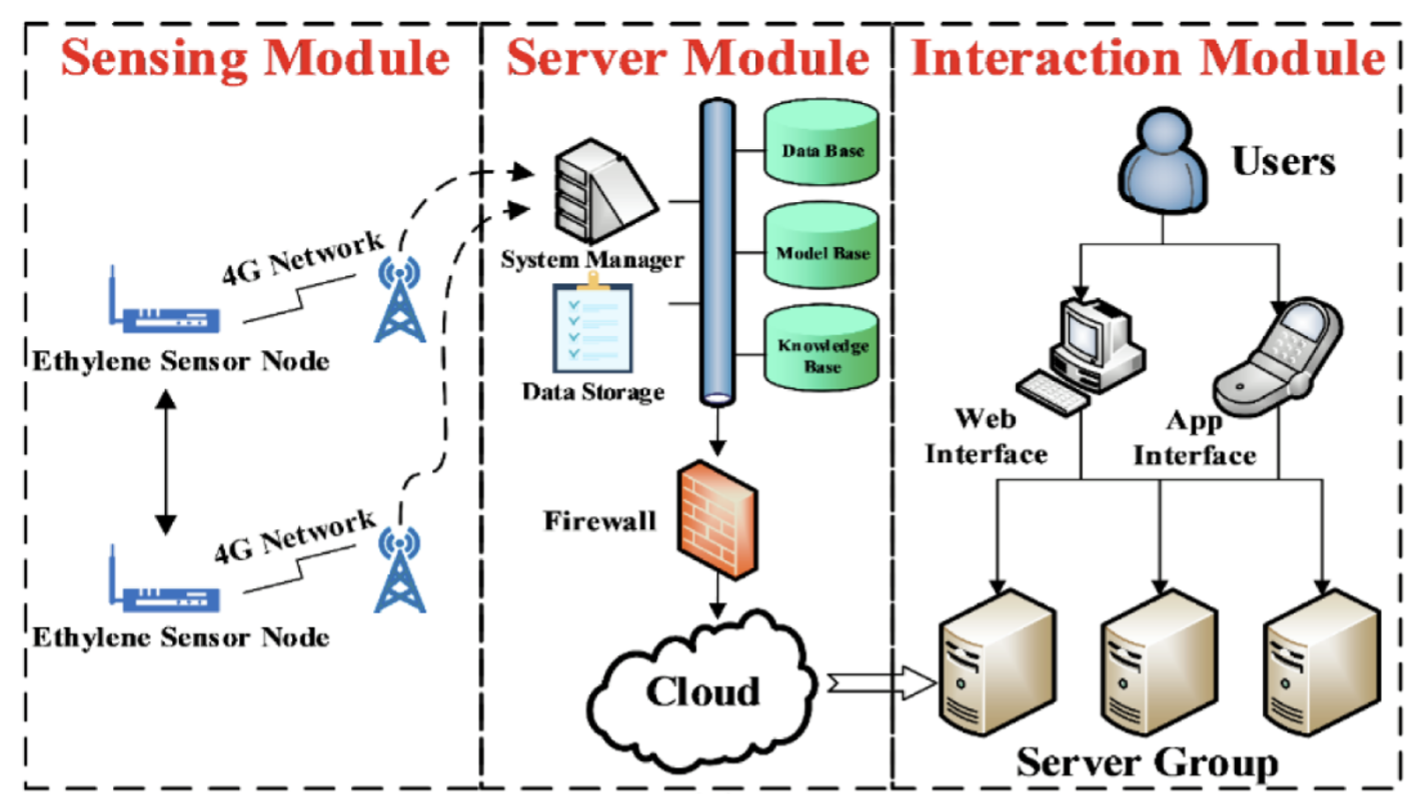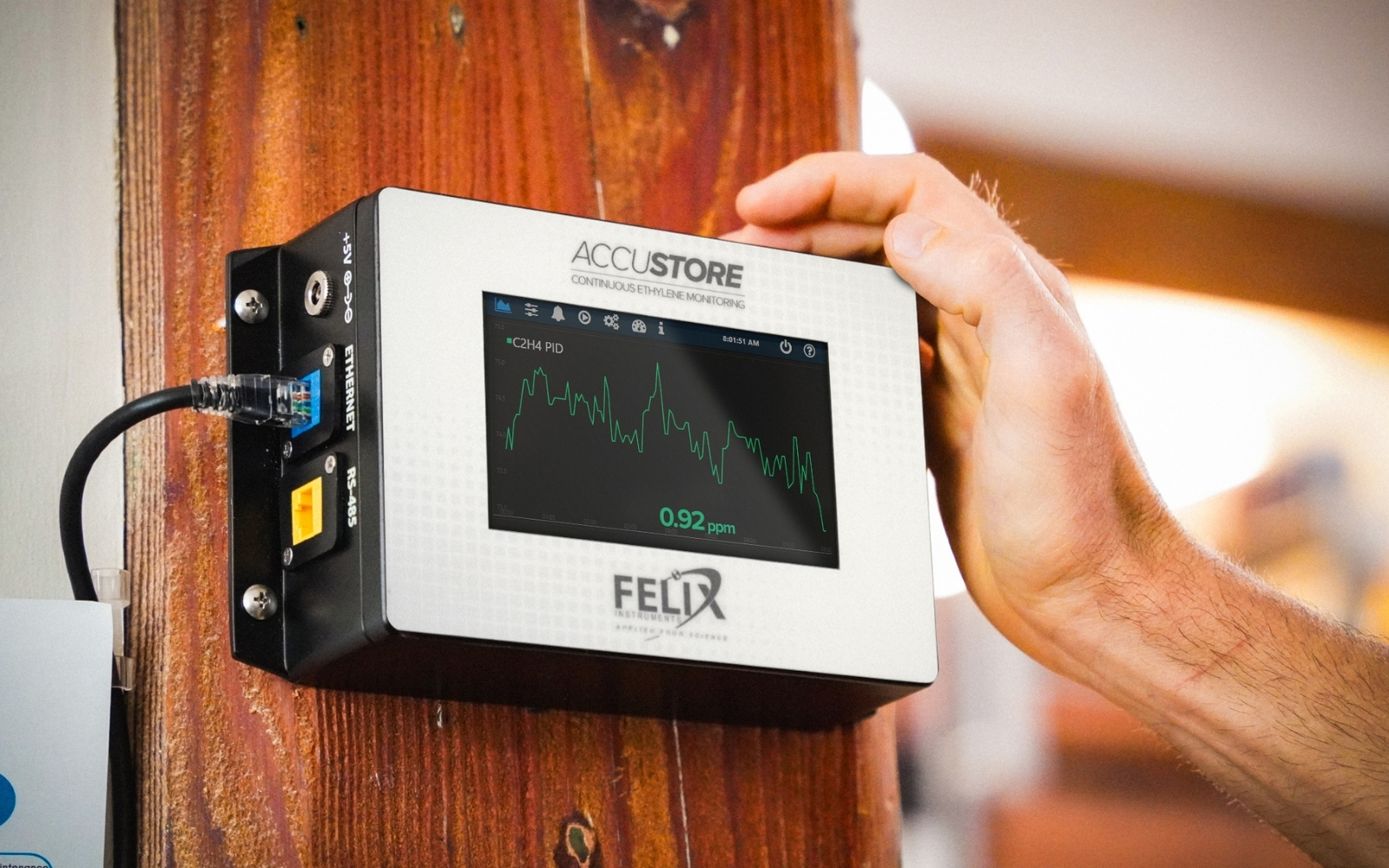September 29, 2025 at 4:39 pm | Updated September 29, 2025 at 4:39 pm | 7 min read
- Ethylene monitoring systems can have fixed or portable sensors.
- Other components of the monitoring systems could be data logging, data transmission, connectivity, remote access, and a control event scheduler.
- The sensors used to detect ethylene must be sensitive, selective, stable, rapid, and have the required lower limit and detection range.
Ethylene monitoring in the postharvest stages is a must to extend the shelf life and safety of fresh produce. The monitoring system can consist of a sensor, data collection, processing, and storage, providing alerts, as well as control mechanisms to regulate ethylene levels. Central to the whole setup is the ethylene sensor, which measures the gas in minute quantities. In this article, we discuss some of the essential features to look for in an efficient ethylene monitoring system.
The Need for an Ethylene Monitoring System
Ethylene (C2H4) gas is a phytohormone produced by plants in various stages of their growth and development. Its economic value lies in its ability to regulate ripening in climacteric fruits and produce desired traits of color, softness, taste, and aroma. However, it also has adverse effects, as it has a propensity to increase senescence, fruit decay, physiological injury, and pathogen activity of a wide range of fresh produce.
The occurrence of ethylene in the atmosphere, from neighboring fruits and vegetables, or due to burning fuel in machines and smoke, can trigger endogenous production of ethylene in fresh produce, leading to unplanned ripening, spoilage, and decay. So, while ethylene is necessary for ripening climacteric fruits, it is also one of the most significant factors that can reduce shelf life and is strictly controlled in the postharvest phases to extend the shelf life of all fresh produce.
Subscribe to the Felix instruments Weekly article series.
By submitting this form, you are consenting to receive marketing emails from: . You can revoke your consent to receive emails at any time by using the SafeUnsubscribe® link, found at the bottom of every email. Emails are serviced by Constant Contact
It is widely acknowledged that even trace elements of ethylene of 0.01 ppm–1 ppm can affect the quality of fresh produce. To control the ethylene levels below those harmful to fresh produce, it is necessary to monitor the storage facilities, transport containers, and retailers around the clock. Ethylene monitoring systems should be able to detect gas levels starting from less than one ppb (parts per billion) in real time to quickly control their levels in the postharvest phases of storage and transport, see Figure 1 for possible applications.

Figure 1. “Conceptual framework of ethylene dynamic monitoring enabled multi-strategies control, Wang et al. 2020. (Image credits: https://www.mdpi.com/1424-8220/20/20/5830)
Ethylene Monitoring Systems
The components of a modern ethylene monitoring system should have precise and sensitive sensors to detect the gas, and other technology that can analyze the data and control the gas levels in real time. It should be possible to integrate the sensors into wireless IoT (Internet of Things) systems, providing remote access and allowing for round-the-clock monitoring of fresh produce facilities without requiring staff presence on site at all times. The system can be portable or fixed, but requires miniaturized technology. The elements of the monitoring systems are shown in Figure 2 and are as follows:
Sensors: These include sensors for ethylene and other environmental factors that affect ethylene generation in fresh produce. The sensors collect data for analysis and are part of the IoT.
- Ethylene detectors: The sensors used to detect ethylene must be sensitive, selective, stable, rapid, with high resolution, and have the required lower limit and range of detection.
- Environmental sensors for temperature, humidity, and other gases: Temperature and humidity can affect the generation of endogenous ethylene, so these parameters are also controlled in a facility. Since higher respiration levels increase ethylene production, oxygen and carbon dioxide levels are also measured.
Servers: In an IoT system, staff have remote access to the monitoring system, and it connects the sensors to the interface elements. In many cases, servers enable data logging to inform decision-making by stakeholders.
Interface: The interface module can be an App or a computer that provides warnings, alerts, displays, and manages equipment and control events.
The exact configuration of the three components will differ. However, gas measurement, data collection, analysis, sounding alerts, and controlling events to regulate gas levels and mitigate risks are necessary to produce quality and extend shelf life.
Other factors that can influence the choice of sensors and the monitoring system are the following:
- Cost of instruments, ease of use, and compatibility with current infrastructure.
- Ease of calibration and maintenance to ensure accurate ethylene measurements.
- The availability of reliable technical support from manufacturers and spare parts.

Figure 2. “The framework of the ethylene dynamic monitoring,” Wang et al. 2020. (Image credits: https://www.mdpi.com/1424-8220/20/20/5830)
Ethylene Sensor Characteristics
Several sensors are available on the market, each using a different principle to detect and quantify ethylene gases. The standard technologies are:
- Gas chromatography
- Electrochemical sensing
- Optical sensing (Non-dispersive infrared spectroscopy)
Each technology has its strengths and weaknesses, and among the available technologies, electrochemical sensing is the most suitable for ethylene detection due to its accuracy, selectivity, stability, rapid response and recovery, and repeatability. The devices must also be able to operate in the environmental temperatures and humidity that exist in cold storage and transport units for fresh produce.
The choice of sensors for ethylene monitoring should focus on their characteristics, which are discussed below.
Selectivity
Selectivity, also called cross-sensitivity, determines the accuracy of the instrument. It is the ability of the sensor to identify only ethylene among other gases that are present in the atmosphere and avoid cross-selectivity. Ethylene measurements are complicated by the presence of ethanol, ammonia, water vapor, and nitrous oxide in the air. For example, ammonia and ethanol could cause cross-sensitivity in optical instruments as their absorption spectra overlap with that of ethylene. Accurate quantitative measurement of ethylene is not possible when different gases are included in the sensor response. High selectivity is critical in real-time measurement of gases and will improve the reliability of the instrument.
Sensitivity
Sensitivity is the ratio of sensor output change to input change and is determined by the technology used. Since ethylene gas needs to be monitored at ppb levels, the sensors must have high sensitivity to detect and measure these trace levels. The exact precision required depends on the application, such as quality control or ripening, and can sometimes necessitate measurements of less than one part per billion. Sensitivity is affected by the temperature and relative humidity of the sensors, the length of exposure to gases, and the response time.
Lower Measuring Limit and Dynamic Range
The monitoring system must have the sensitivity to measure the minimum concentrations at which ethylene can affect fresh produce.
Instrument sensitivity can be correlated to the detection range, that is, the difference between the minimum and maximum limits of the gas to be monitored. Some technologies are not equally sensitive to the entire range of measurements required. For example, optical instruments are more sensitive to specific wavelengths than others, and are not reliable for measuring the full range of ethylene that must be monitored. Therefore, it is essential to consider the performance of the technology and the dynamic range, which is the range within which the instrument maintains accuracy, when selecting a monitoring system.
Response and Recovery Time
Response time is the time needed by an instrument to change from zero and reach 90% of its maximum signal after exposure to ethylene, compared to when there is no ethylene in the air. Manufacturers report the response time of their devices as T90. For real-time monitoring, detection, and analysis to be effective, they must be rapid, especially in dynamic ripening environments, to prevent over-ripening and food loss. Response time will depend on the technology and can take a few seconds to a few minutes.
Recovery time is the time that a sensor needs to return to baseline values of zero after the ethylene source is removed.
Different sensing technologies have varying response and recovery times. For rapid measurements, response and recovery times are crucial, and together, they represent the time required by an instrument from the beginning of a measurement to a state of readiness for new ethylene measurements.
Stability
Stability refers to the long-term stability of the response during the working time. It depends on zero drift and interval drift. Zero drift is the change in sensor output response over the entire working time when there is no target gas or ethylene in the air. Interval drift is the output response change when the sensor is continuously in air that has ethylene, which can often result in a decrease in signal over time. A sensor should be able to have stability even during low-level detection.
A good continuous sensor should have an annual zero drift of less than 10% and remain stable for two to three years under varying conditions.
Operating Conditions
Very high sensor temperatures can damage the instruments. Also, high water vapor in the air reduces sensor sensitivity. So, the instruments should be optimized to operate in the extreme conditions that exist on-site in the fresh produce supply chain.
Calibration
Environmental conditions, long-term use, and aging can all reduce the performance of an ethylene sensor. Sensitivity and response time are most impacted, but so are the other characteristics of a sensor. Moreover, instruments can have sensor discreteness or slight differences in individual instruments from the same producer. Proper and regular calibration can partially remedy these problems. Users should follow the manufacturer’s instructions for calibration.
The Standard Sensor
Among the various technologies available, electrochemical sensors offer the best combination of characteristics and are the standard technology used in ethylene portable and fixed detectors.
Felix Instruments Applied Food Science offers a range of ethylene detectors, with lower limits and dynamic ranges optimized for various ethylene monitoring applications in the food supply chain. The fixed detectors have a sensor unit and a control unit that can be connected through servers, such as Modbus and Ethernet. The sensor unit has detectors for ethylene, oxygen, carbon dioxide, temperature, and relative humidity. It has more than one interface option, sends sound and email alarms, and has a control event scheduler. The company also offers several portable options for monitoring ethylene.
Find out more about Felix Instruments’ fixed and portable detectors for your ethylene monitoring needs.
Sources
Caprioli, F., & Quercia, L. (2014). Ethylene detection methods in post-harvest technology: A review. Sensors and Actuators B: Chemical, 203, 187-196. https://doi.org/10.1016/j.snb.2014.06.109
Chen, X.; Wreyford, R.; Nasiri, N. (2022). Recent Advances in Ethylene Gas Detection. Materials,15, 5813. https://doi.org/ 10.3390/ma15175813
Gwanpua, S. G., Jabbar, A., Tongonya, J., Nicholson, S., & East, A. R. (2018). Measuring ethylene in postharvest biology research using the laser-based ETD-300 ethylene detector. Plant Methods, 14, 105. https://doi.org/10.1186/s13007-018-0372-x
Hu, K., Cai, Y., Wang, Z., Zhang, Z., Xian, J., & Zhang, C. A Review on Metal Oxide Semiconductor-Based Chemo-Resistive Ethylene Sensors for Agricultural Applications. Chemosensors, 12(1), 13. https://doi.org/10.3390/chemosensors12010013
Janssen S, Schmitt K, Blanke M, Bauersfeld ML, Wöllenstein J, Lang W. 2014. Ethylene detection in fruit supply chains. Phil. Trans. R. Soc. A 372: 20130311.
http://dx.doi.org/10.1098/rsta.2013.0311
Leangtanom, P., Wisitsoraat, A., Jaruwongrungsee, K., Chanlek, N., Phanichphant, S., & Kruefu, V. (2020). Highly sensitive and selective ethylene gas sensors based on CeOx-SnO2 nanocomposites prepared by a Co-precipitation method. Materials Chemistry and Physics, 254, 123540. https://doi.org/10.1016/j.matchemphys.2020.123540
Lo Dayekh, M., & Azara Hussain, S. (2023). Gas Sensor and Sensitivity. IntechOpen. doi: 10.5772/intechopen.108040
Wang, X., Li, X., Fu, D., Vidrih, R., & Zhang, X. Ethylene Sensor-Enabled Dynamic Monitoring and Multi-Strategies Control for Quality Management of Fruit Cold Chain Logistics. Sensors, 20(20), 5830. https://doi.org/10.3390/s20205830
Wusiman, M., & Taghipour, F. (2021). Methods and mechanisms of gas sensor selectivity. Critical Reviews in Solid State and Materials Sciences, 47(3), 416–435. https://doi.org/10.1080/10408436.2021.1941752
Zhang, S., Xia, X., Xie, C., Cai, S., Li, H., & Zeng, D. (2009). A method of feature extraction on recovery curves for fast recognition application with metal oxide gas sensor array. IEEE Sensors Journal, 9(12), 1705-1710.
Zhang, X., Li, Y., Hong, T., …Marinkovi´c, D. (2023). Response Characteristics Study of Ethylene Sensor for Fruit Ripening under Temperature Control. Sensors, 23, 5203. https://doi.org/10.3390/s23115203
Related Products
- F-751 Grape Quality Meter
- Custom Model Building
- F-910 AccuStore
- F-751 Melon Quality Meter
- F-751 Kiwifruit Quality Meter
- F-750 Produce Quality Meter
- F-751 Avocado Quality Meter
- F-751 Mango Quality Meter
- F-900 Portable Ethylene Analyzer
- F-950 Three Gas Analyzer
- F-920 Check It! Gas Analyzer
- F-960 Ripen It! Gas Analyzer
- F-940 Store It! Gas Analyzer
Most Popular Articles
- Spectrophotometry in 2023
- The Importance of Food Quality Testing
- NIR Applications in Agriculture – Everything…
- The 5 Most Important Parameters in Produce Quality Control
- Melon Fruit: Quality, Production & Physiology
- Fruit Respiration Impact on Fruit Quality
- Guide to Fresh Fruit Quality Control
- Liquid Spectrophotometry & Food Industry Applications
- Ethylene (C2H4) – Ripening, Crops & Agriculture
- Active Packaging: What it is and why it’s important





